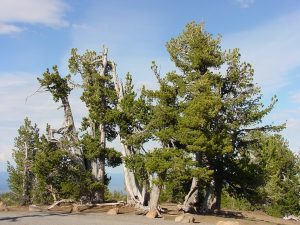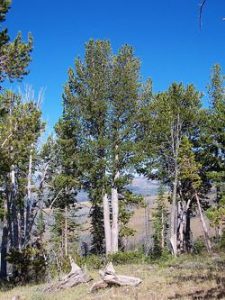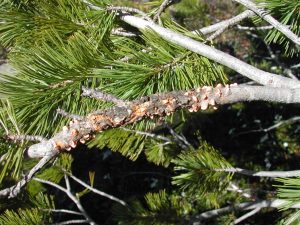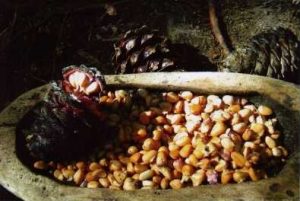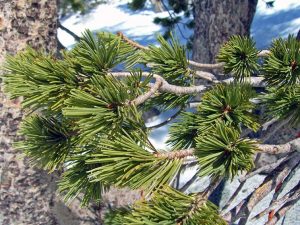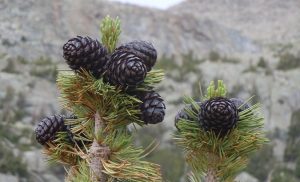Whitebark Pine
Whitebark pine or white pine is a species of small- to medium-sized subalpine conifers found at mid to high elevations in the mountainous regions of Canada and western United States. From small trees with broad crowns and rapidly spreading trunks to shrubs with twisted branches and widely extended crowns, the whitebarks vary in shape as they are continuously exposed to severe freezing winds.
Scientific Classification
| Kingdom | Plantae |
| Division | Pinophyta |
| Class | Pinopsida |
| Order | Pinales |
| Family | Pinaceae |
| Genus | Pinus |
| Subgenus | Strobus |
| Scientific Name | Pinus albicaulis |
Quick Information
| Other Names | Whitestem, scrub pine, creeping pine, pitch pine, pin à blanche écorce (French) |
| NRCS Code | PIAL |
| Size | Ranges from 12-18 m (40-60 ft) with a trunk diameter of 1.5 m (5 ft) |
| Leaves (Needles) | Stiff, slightly curved, occur in bundles of five per fascicle; 3-9 cm long, bluish-green; clustered towards the base of the branches |
| Cones | Round/egg-shaped, growing perpendicular to the branch; purple when young; scales grow in five spiral rows; seed cones remain closed even after drying |
| Bark | Smooth, thin, chalky-white in young trees; becomes thicker with slender, brown, scaly plates |
| Distribution/Range | Alberta, British Columbia (in Canada); California, Montana, Oregon, Nevada, Idaho, Wyoming, Washington (in the US) |
| Hardiness Zones | Zone 2 |
| Growth Rate | Slow |
| Lifespan | Can live for over 500 years |
| Growing Conditions | Winter Conditions: Mean winter temperature ranges from -9° to -5° C; grows in cold, windy, and snowy climatic regions Summer Conditions: Short, cool summers; mean temperature ranges from 13°-15° C Rain: Grows in areas where mean annual precipitation ranges from 600-1800 mm Sunlight: Requires full sunlight, shade-intolerant Soil Requirements: Poorly/moderately developed, well-drained, basic/acidic, coarse/sandy/loamy |
| Threats | Damaging insect pests include mountain pine beetle, aphids, mealybugs, lodgepole needletier, and Monterey pine Ips; diseases such as white pine blister rust, wood rots, and butt rots infect the tree; wildfires |
| Flowering/Fruiting | Pollens are shed in early July; however, at some sites, it flowers in June; female/seed cones ripen during early September of the 2nd year |
| Breeding System | Monoecious |
| Seed Production | Cone crops are produced more frequently than seed crops |
| Seedling Development | Seeds have a poor germination rate; germinated seedlings are larger than other mountain conifers measuring 8-10 cm in cotyledon stage |
| Wildlife Value | Provide shelter and nesting habitat for animals and birds in harsh conditions; their large seeds serve as a food source for Clark’s nutcracker, black and grizzly bears, Douglas squirrels, deer mice |
| Cultivars |
|
| Uses | In land-reclamation projects for stabilizing rocks, soil, and snow on steep terrain; hikers and campers use them for fuel and shelter; earlier used for supporting the mining industry in Montana |
| IUCN Conservation Status | Endangered |
Interesting Facts
- The oldest whitebark pine with an age of 1267 years, identified by tree ring dating, has been found in the Sawtooth Mountains in central Idaho.
- An organization named Whitebark Pine Ecosystem Foundation has been established in order to protect and raise awareness about the species by funding restoration projects, hosting annual workshops, and publishing newsletters.
References
- https://www.conifers.org/pi/Pinus_albicaulis.php
- https://en.wikipedia.org/wiki/Pinus_albicaulis
- https://www.americanforests.org/wp-content/uploads/2018/01/01-Introduction-to-WBP_Tomback.pdf
- https://www.iucnredlist.org/species/39049/2885918
- https://www.fs.usda.gov/database/feis/fire_regimes/Whitebark_pine/all.html


